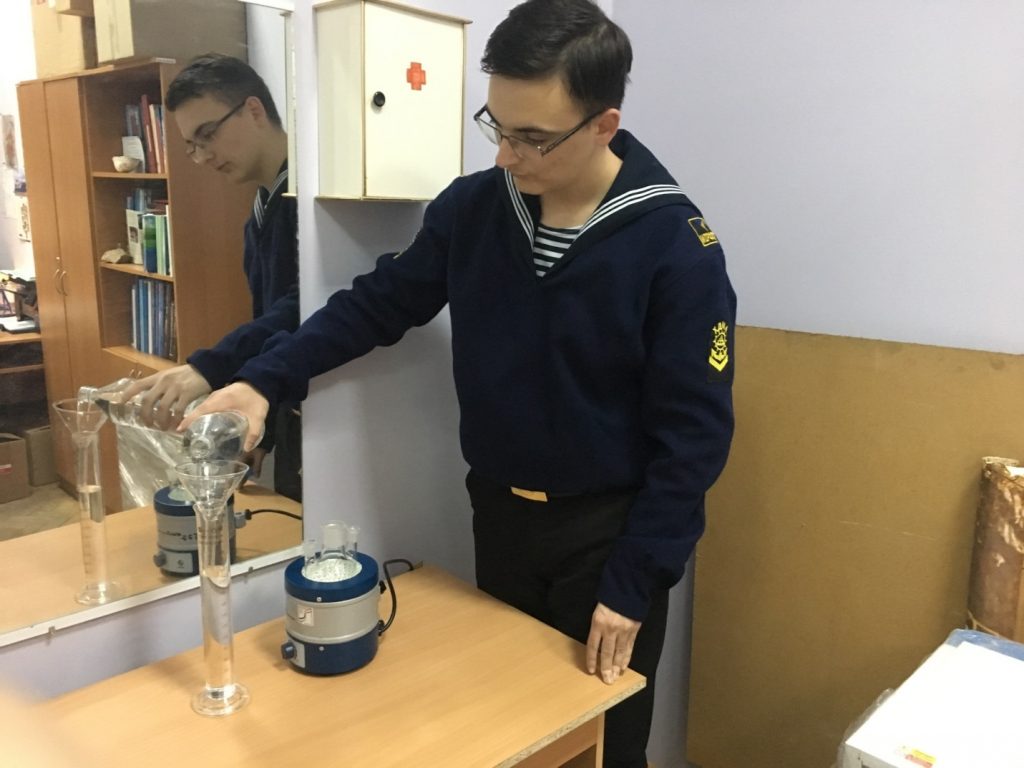The activities of the laboratory Marine Ecology in the operation of ships are aimed at the development and implementation of new, effective methods for the protection of the sea and the environment during the operation of ships, extraction of hydrogen sulphide from the Black Sea and its processing on floating platforms or onshore complexes into heat, electricity, environmentally friendly fuel – hydrogen, mineral fertilizers, chemical compounds, processing and neutralization ballast waters.
A scientific group of cadets conducts researches in the direction of “Protection of the marine environment during the operation of ships”.
Using the laboratory equipment, KSMA scientists have developed a number of new technologies and technical solutions protected by patents of Ukraine:
- a method of obtaining low-sulfur marine fuel from the raw materials of a reducing nature, from grain crops of rape. The aliphatic alcohols C2-C5 + and / or their mixtures of a reducing nature are used. The liquid solutions of alkalis, salts are used as a cocatalyst, carboxylic acids and / or their mixtures at temperatures of 40-70 ° C. The pressure is close to atmospheric. The weight velocity for raw materials WHSV = 0.2-5.2 h-1;
- a method of obtaining marine fuel for marine power plants. A plastic waste is used as a raw material. The high-density low-pressure polyethylene is washed, dried, crushed to a fine state of 10 fractions (0.1-0.5 mm), melted at a temperature of 170-175 ° C to a homogeneous state, kept at 5 hours to stabilize the solution. It is sequentially added, with a time delay at 3 hours, into the solution of sample No. 1. The last one contains (wt. %): distilled water – 90-98, alcohol-containing compounds – 1-5, medium-temperature hydrocarbons – 1-5. The sample No. 2 contains (wt. %): distilled water – 85-93, alcohol-containing compounds – 1-5, medium-temperature hydrocarbons – 1-5, 15 potash K2CO3-5. The sample No. 3 contains (wt. %): distilled water 85-93, alcohol-containing compounds – 1-5, medium-temperature hydrocarbons – 1-5, potassium permanganate KMnO4-5;
- a method of neutralizing potent toxic substances, pesticides, by processing in a high-temperature oven. The substances undergo high-temperature pyrolysis in combination with oxidative neutralization. This process containing the following stages: loading, dissolving large pieces of pesticides in the water, loading into a high-temperature calcining furnace, carrying out a combined pyrolysis process at a temperature of 1500-2000 ° C. After the neutralization time t = 0.1-0.3 hours, a solution of an active oxidant in a sprayed state is injected into the high-temperature zone of the calcining furnace. The calcining furnace is cooled to ambient temperature. Then a safe waste ash (slag) is unload from the furnace;
- a method of obtaining oxygen from atmospheric air by the method of low-temperature fractionation and / or by the method of diffuse separation on selective long-acting membranes. The water and / or carbon dioxide are used as feedstock. They are dissociated into oxygen, hydrogen, carbon in the presence of cumulative exposure, third generation selective catalysts. The hydrogen and carbon are formed as a result of secondary processes.



